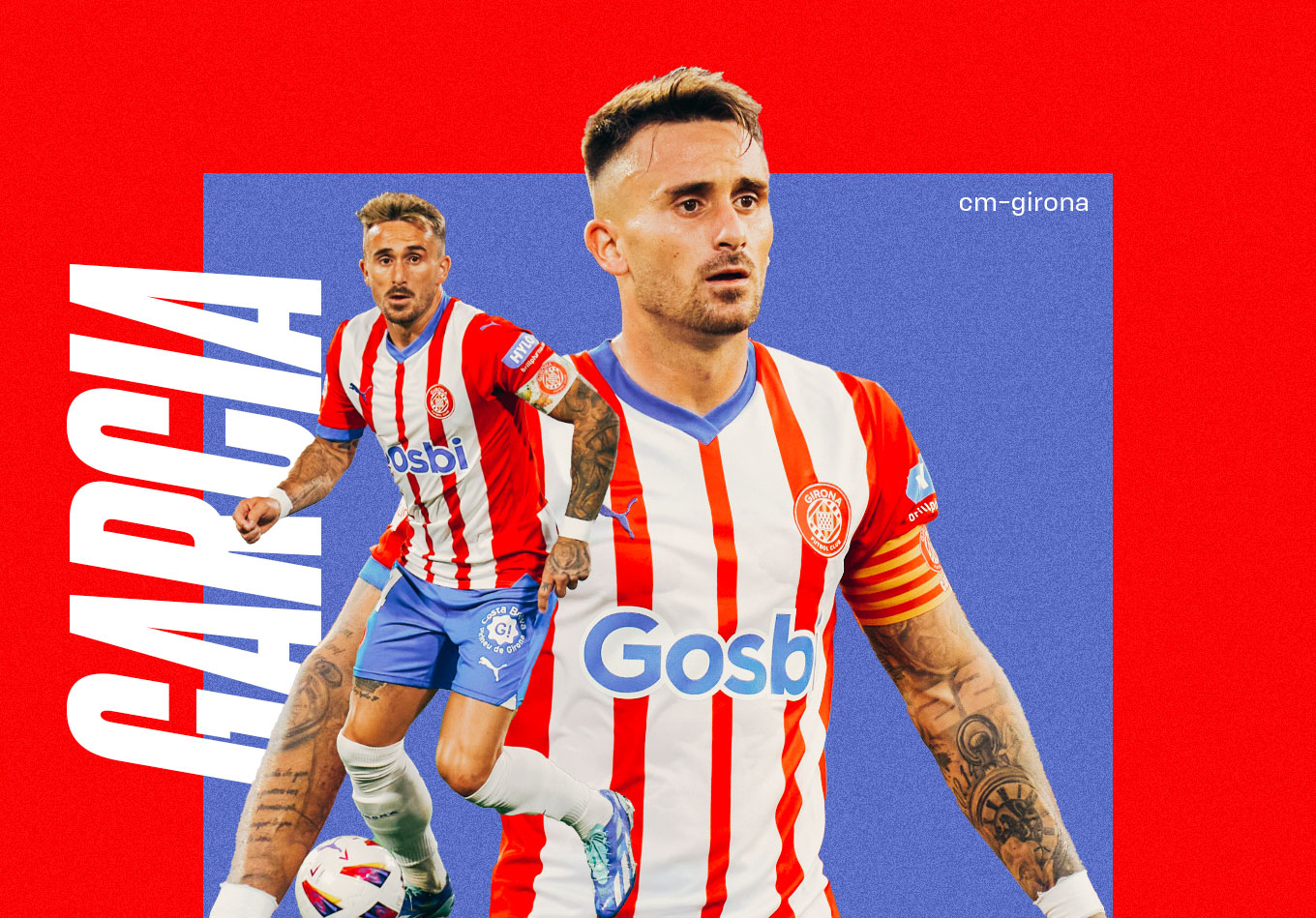Girona Futbol Club have been in existence for 93 years, and it took all 93 of them to see one of their players earn a call-up for the Spanish national team. On 16 November, just under a week after earning the call, Aleix García became the first player in the club’s history to don the shirt of La Roja. Turns out, to break a 93-year record, you need to be pretty special…
Aleix García’s national team call-up is symbolic of the way things are going for Girona at the moment. La Liga’s current leaders have taken 34 of a possible 39 points this season, scored more goals than anyone else (31), and only failed to win against two Champions League sides.
They’re the best team in Spanish football as it stands, and they’ve got a good claim to playing better football than anyone else too.
As for García, he could argue he’s playing better football than any midfielder in Spain not named Jude Bellingham. And, well, there’s no shame in being second there.
Though they are wildly different types of players, what the pair of them share is the ability to affect the game across every third of the pitch. Bellingham conquers through a combination of physicality, force of play, and expressive on-ball talent, while García pairs a smoothing of play in the first two thirds with a quality of final ball that few can rival.
Where Bellingham has made the difference himself, García has positioned his teammates to make the difference. And there can be no greater appraisal of that than seeing where Girona currently are.
It’s hard to believe now, but Girona started this season with doubts about how they were going to fare following the departure of Oriol Romeu to Barcelona. The 32-year-old was Míchel’s rock in midfield last season; the player who balanced the team with and without the ball, and through whom the Girona boss would translate his messages to the pitch. In his absence, it was logical to think the team’s structure would suffer.
By the time the season began, Girona’s solution for replacing Romeu had been a novel one: to not replace him at all.
Given the task of finding a player with defensive presence and the requisite technical ability on their modest budget, they decided to work in the opposite direction. It wasn’t about chasing the lost defensive attributes or the command that Romeu emanated, it was about modifying their approach to be able to play a different game; one in which they would have less need for what they were losing.
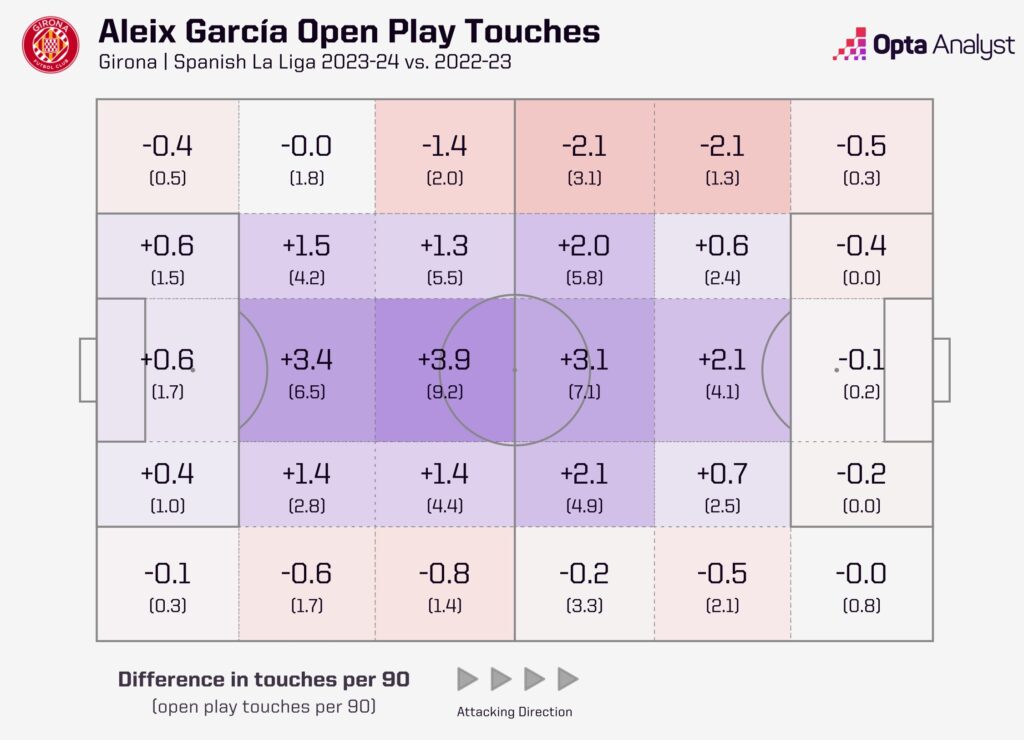
A series of alterations were made for that to occur. García was brought back to a more permanent role at the base of midfield, while Girona’s centre-back profiles changed drastically following the arrival of possession specialists Daley Blind and Eric García. Míchel’s bet was centred on ramping up their control of play and territory, so that Romeu’s role as the anchor and layer of defensive protection wouldn’t be as necessary.
If they could be sharper on the ball, play further from their own goal, and position themselves more optimally to recover the ball once they lost it, the necessity for a specialist anchor would be diminished.
“With Aleix, what we’ve got now is about trying to keep the opposition deeper and in their defensive third, so that our pressing after a turnover is more energetic from back to front,” Míchel explains.
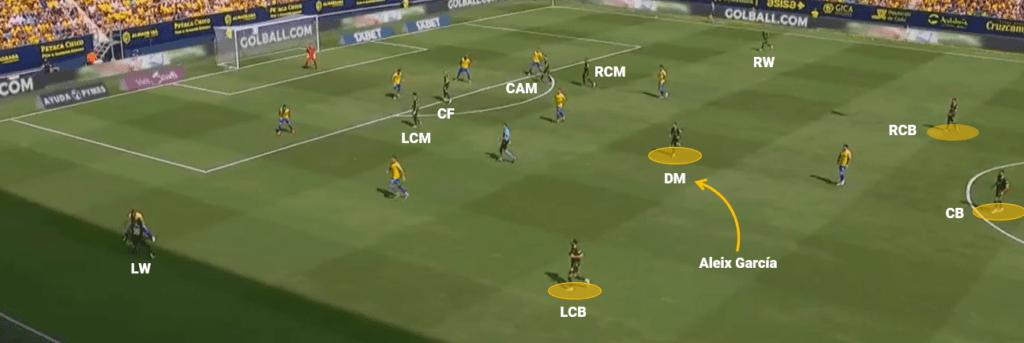
Thirteen games into the season, the league leaders are the team who’ve made the biggest jump from 2022-23 in terms of lengthening their spells of play. Girona have averaged just over 13 sequences of 10+ passes per game in open play this season, up from 9.5 last season. On average, they move the ball upfield slower than anyone else in La Liga. And what’s more, they’re averaging 11.6 seconds per sequence of play this term – a league-high increase on last season (+1.5s).
If that doesn’t sound like much, ask yourself how many times you’ve heard managers referring to players having less and less time to make decisions. Add that extra one-and-a-half seconds up over the course of thousands of sequences of play, over the course of a season, and it’s a drastically different situation on the pitch. Girona have – quite literally – accelerated their rise by slowing themselves down.
For García, that extra second of possession has been frankly terrible news for the rest of La Liga. Within Girona’s new structure, the 26-year-old has settled into a quarterback role where he flits between directing the flow of traffic in the build-up, providing continuity to the play, and, most devastatingly, using his panoramic view of the pitch to pick apart the opposition’s shape from the outside.
He leads all players in La Liga for completed passes this term (867). Not since 2016-17 has a midfielder held onto that spot by the end of the season without playing for either Real Madrid or Barcelona.
If you have a winner of duels there, maybe you don’t need to have more control of the play, because [Romeu’s] going to recover the ball. Now, we know that Aleix García has other characteristics. Clearly the centre-backs that have arrived also have other characteristics to Santi Bueno, for example, or Juanpe or Bernardo… they’re different players. So, I had to mould the idea that we have, provided that we continue being competitive in my idea of seeing the game.
Míchel, La Liga interview (17th October)
Evidently, for a team averaging 2.4 goals per game this season, Girona playing a slower and more deliberate game doesn’t mean that’s their only setting. Their management of tempo is based on the picture in front of them and what the opposition is doing. When eventually that landscape opens up and a decision is made to go, Girona eat up the grass as quickly as anyone. And most of the time, it’s a journey that begins from the boots of García.
Given the improved security on the ball provided by their centre-back trio, Girona are comfortable in committing players forward and occupying the opposition with up to six attackers across the width of the pitch. In the space in between, García is the man with the best view in the house and the best right foot in Spanish football. From his featured role at the genesis of Girona’s attacks – often occupying the ‘one’ in their 3-1-6 – the 26-year-old has become the director of Spain’s most fluent team.
The main way in which García differentiates himself as a passer is through his longer distribution, but not merely that he has the capability to spray the ball to all corners of Montilivi. What makes his distribution special is that his unlimited range doesn’t come at the expense of efficiency. The 26-year-old passes with ambition while managing to retain the ball as if he were playing a safe game.
“The best pass is to the player furthest from you, but you have to know how to interpret it,” he told El País in March.
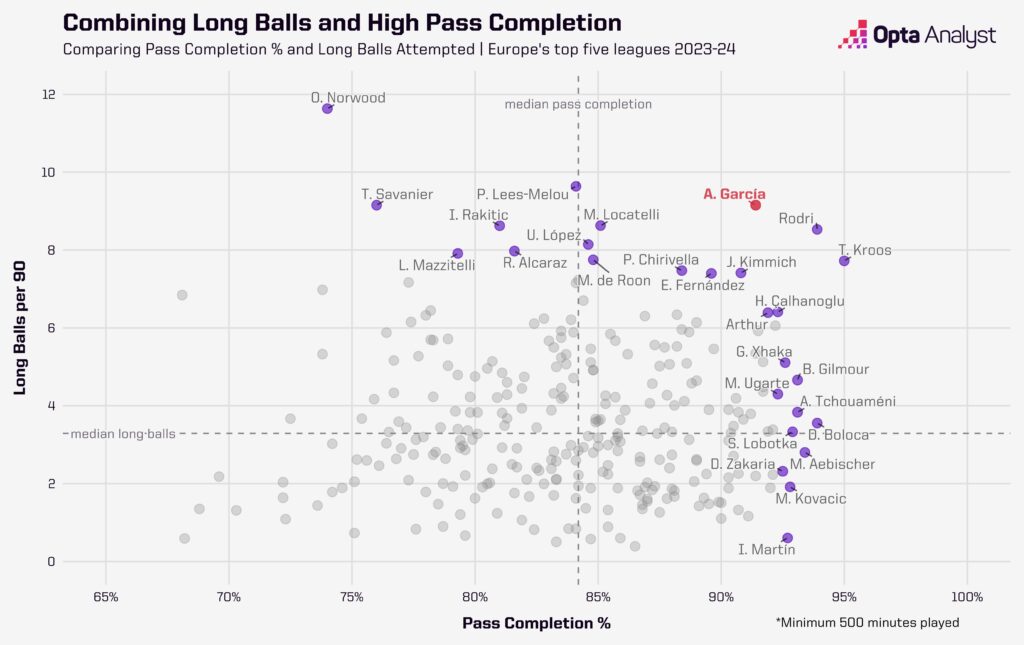
While Girona are dominating at close quarters, García is the reliever that the opposition fear – the one who can flip a short passing sequence into an attack 60 yards away. Indeed, the difficulty of containing the Catalan side is apparent through their excellence in combining at close quarters, while also being able to change the point of attack in an instant through García.
With the growing importance of out-of-possession approaches – especially when facing teams skilled in the art of build-up – the Girona man is the antidote to the opposition leaving a man unmarked on the opposite side of the pitch. Using maximum width is a permanent feature of Míchel’s team, and through García, they have the means to use every last bit of it.
He has made more successful switches of play than anyone else in Europe’s big five leagues this season (29) – already just four fewer than in the whole of last term – and most of them are the long, lofted diagonals that change their attacking dynamic.
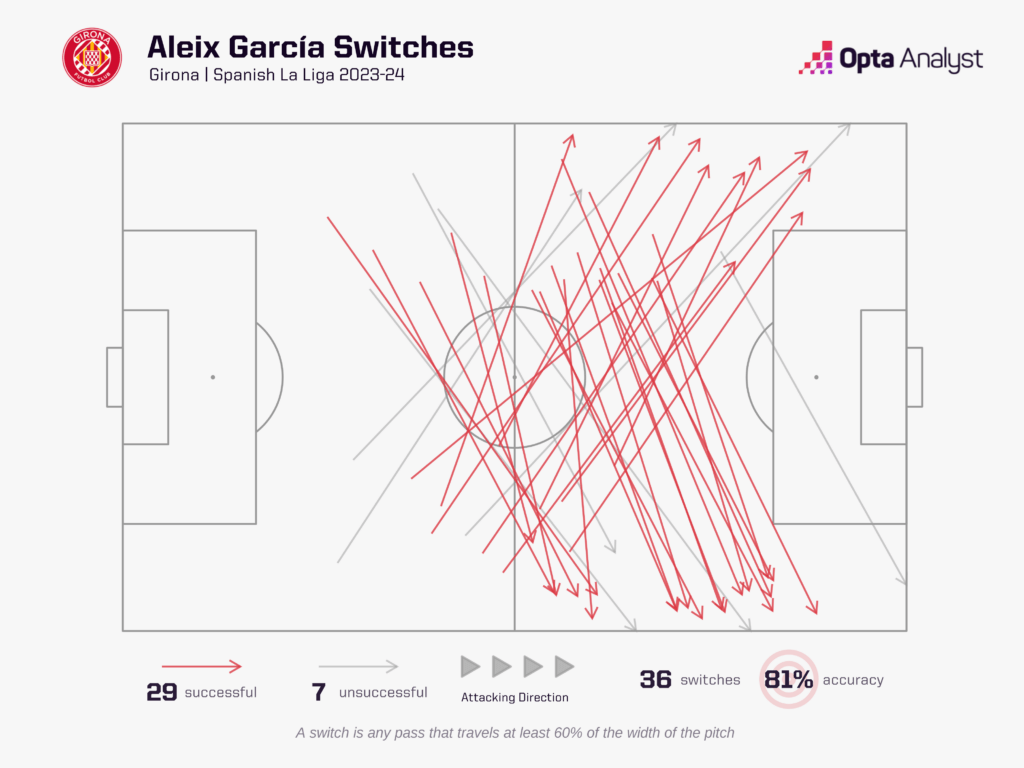
In fact, when it comes to accessing wide players with those longer passes that arrive in less protected spaces, Girona’s receivers might well be the most grateful in Europe. García has found right winger Yan Couto with a long ball on 30 occasions this season, the most by a player for a specific teammate in Europe’s top five leagues.
The winger who’s received the next-most on the list? That’d be the guy on the other side – Sávio – whom García has connected with 27 times over that longer distance.
Sávio, to highlight him for a second, has been one of the revelations in La Liga this season. The Brazilian winger is a self-sufficient talent in many ways, but he’s also benefitted enormously from the conditions that García, in particular, provides for him as a passer.
With the teenager often holding maximum width on the left side, he has to trust in his teammates to be able to deliver the ball to where he is, rather than him going looking for it.
“It’s true that we train a lot on the idea of generating space inside to [then] play out wide and generate 1-v-1s,” Míchel says.
For the Brazilian, that process of involvement could hardly be going better. He leads all players in La Liga this season for expected assists (4.1), while only Bryan Zaragoza (37) has completed more take-ons than him (30).
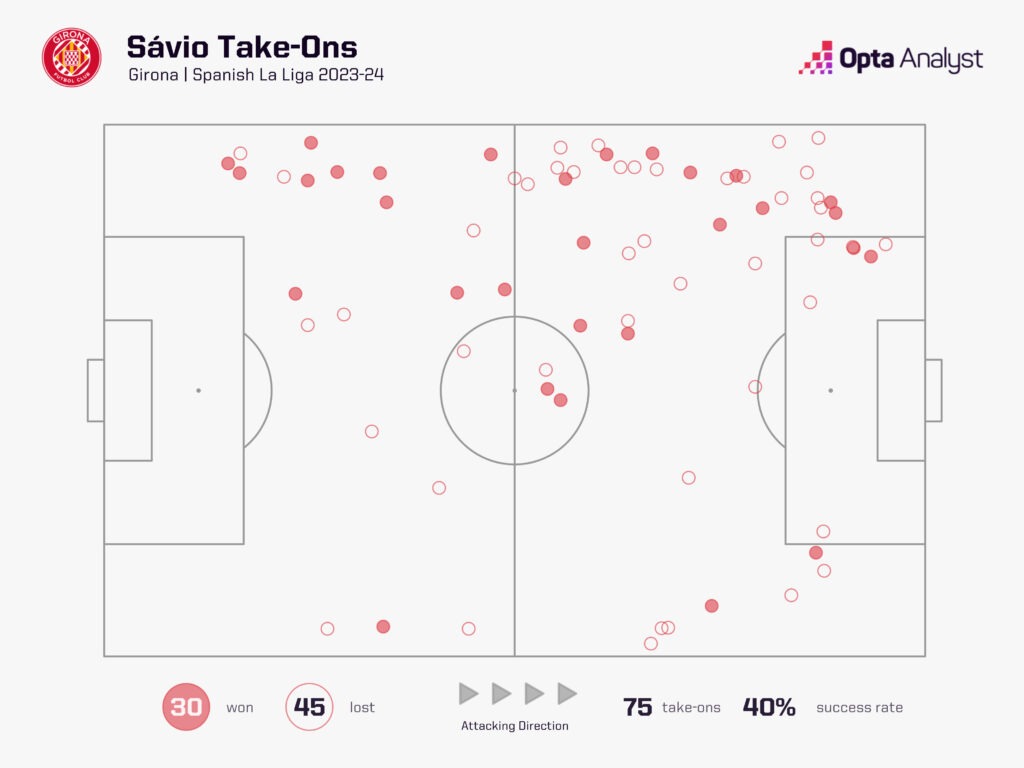
What’s interesting about Sávio’s impact as a creator is that 30 players have created more chances than him this term (15), and yet he still leads the league in overall chance quality, in terms of expected assists.
Girona don’t generate overwhelming volume through their wingers. Instead, they find them at optimal moments for them to do maximum damage. With his role in feeding those players, García tops the charts in La Liga this term for both secondary chances created (20) and secondary assists (5) – essentially, the pass that comes directly before either a chance is created, or an assist is made. It is football’s equivalent of setting the table.
Oriol [Romeu] used his body; Aleix [García] uses the speed of his gestures, his touch… Oriol was able to control a ball with somebody on top of him, turn and keep it. Aleix, in that type of duel, isn’t so much of a winner, but Aleix positions himself so that before the pressure arrives, he can already find a pass.
Míchel, La Liga interview (17th October)
With their growing reputation as an attacking force, Girona are now – naturally – facing more situations of being camped in the opposition half. That’s what Míchel wanted, remember, and it comes through his side being increasingly able to pen their opponents in, along with opponents being concerned enough to prioritise limiting space over other out-of-possession ambitions. It’s a reality that shifts the context for a player like García, whose work usually plays out at the base of midfield.
The problem for Girona’s opposition is the closer García gets to goal, what before was a passing threat, then becomes a threat of dangerous ball striking. Of the many different ways in which the great distributors exact their game, García’s is rooted in his variety of techniques. When he’s closer to goal, those floated strokes around the park give way to devastating connections.
The 26-year-old is playing in a deeper, more directorial role this season, and yet ironically, he’s chipping in with goals more than ever. He’s scored three times in La Liga this campaign, after scoring just once in 30 games last term, and zero in 42 games in their promotion campaign of 2021-22. His three goals this season have been scored by an average distance of 17.4 yards, with only Take Kubo (four) netting more times from at least 15 yards.
Two of the three, meanwhile, proved to be game-winning goals – that’s an extra four points directly from the midfielder’s right foot.
García’s striking from distance is representative of Girona’s varied attacking threat, in that without it being critical to their play, it’s a facet of their game opponents can’t afford to ignore. With the number of players the Catalan side flood the box with, opponents can fall into the trap of leaving space on the edge of the box for García to sneak into.
Indeed, for his winner at Cádiz earlier in the season, Míchel remarked after the game that they had planned for cut-backs to the edge of the box for García, given how well the home side were defending their area. And on a day where their usual avenues of attack didn’t produce, it was his strike from a cut-back that secured the points.
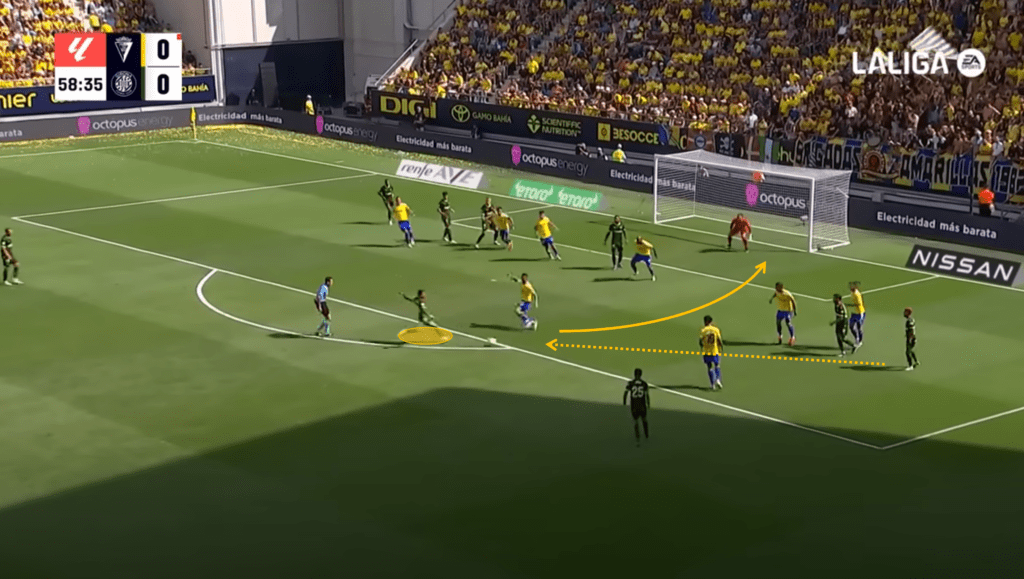
In many ways, that winner at Cádiz was essentially a set play from open play. The fact it was a successful one doesn’t come as a surprise, for another aspect of Girona’s play where García’s ball striking alters their potency is – you guessed it – set-pieces. If you’re holding onto dreams of the Catalan side ‘doing a Leicester’ this season, you’ll be pleased to hear they’re a menace from them.
Girona aren’t the top scorers in that aspect in La Liga this season, but they do have the highest xG from set-pieces (5.3), when excluding penalties. For a team who aren’t exactly littered with six-foot players or aerial specialists in defence, Míchel’s side find their value there through changing the angles of delivery, but mostly through the pure quality of delivery.
Here’s Aleix making life pretty easy for another García (Eric), with a textbook punched cross:
Well, we made it this far before finding a category of distribution that the Girona midfielder isn’t top of. He ranks second in La Liga this season for successful corners into the box (14), behind Isco (17), who also narrowly beats him out for corners with a shot attempt on first contact. If it weren’t for that international call-up, he could have spent the last two weeks working on corners at La Vinya.
All in all, García’s season so far has been an exhaustive display in how many ways a distributive midfielder can affect a game of football. The 26-year-old is the embodiment of Girona themselves, pairing incision with precision, and continually creating hazards that their opponents need to prepare for.
What’s clear is, if you want to stop Girona this season, you’re probably going to have to stop Garcíá first.
Enjoy this? Subscribe to our new football newsletter to receive exclusive weekly content. You should also follow our social accounts over on X, Instagram, TikTok and Facebook.
